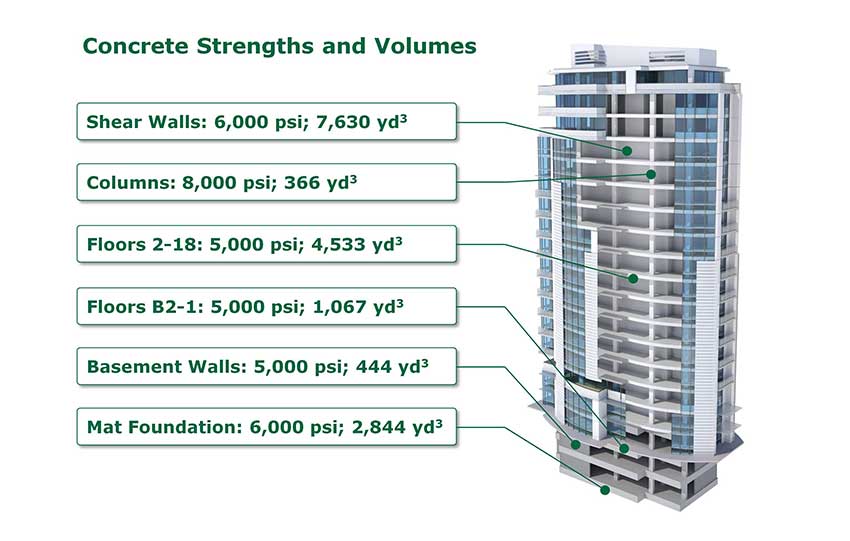When looking at the environmental impact of a building, it is important to assess every stage of the environmental life cycle, from material extraction and product manufacturing to building operations and maintenance through to end-of-life. Concrete offers many environmental attributes that help reduce the overall environmental life-cycle impacts of a building. This course explores how life-cycle assessment can be used to measure and lower the environmental impacts of buildings, including carbon footprint.

NRMCA Skanska USA Commercial Development, Inc.
Capitol Tower, Houston, TX. This 35-story, 750,000-square-foot, Class A office building features concrete pan-formed beams with post-tensioned girders, a mat foundation, and concrete core/shear walls. Developer: Skanska. Architect: Gensler; Structural Engineer: Walter P. Moore
Life-Cycle Assessment and Concrete
Architects are increasingly interested in reducing the environmental impact of the buildings they design—and for good reason. Buildings account for nearly 40 percent of C02 emissions. C02 emissions are directly responsible for climate change, which we now know will continue to have far-reaching negative impacts if no action is taken. To mitigate climate change, the latest Intergovernmental Panel on Climate Change (IPCC) report states that global warming needs to be limited to 2.7°F (1.5°C). That goal, the report says, requires a “rapid and far-reaching” transition in land, energy, industry, buildings, transport, and cities. The climate change message can often feel dire, but, in fact, it is one of great opportunity: with the right tools and approach, the built environment can go from being a major contributor to climate change to becoming a leader in innovative solutions.
Of the annual emissions buildings emit, 28 percent are due to building operations, while emissions from building materials and construction (referred to as embodied carbon) are responsible for an additional 11 percent annually. Unlike operational carbon emissions, which can be reduced over time with building energy upgrades and the use of renewable energy, embodied carbon emissions are locked into place as soon as a building is built. For this reason, it is essential to predict emissions and reduce carbon impacts from the beginning of a building project. Architect 2030, a nonpartisan, nonprofit organization working to rapidly transform the built environment from emitter to climate solver, states on its website that getting a handle on embodied carbon now will help the U.S. hit the net-zero emissions goals of the Paris Climate Accord by 2050 and aid in moving the world toward a better climate future.
In conjunction with climate change, new construction is on the rise, which means assessment tools for embodied carbon are more important than ever. Achieving net-zero embodied emissions will require adopting three principles: reuse, reduce, and sequester. Reusing includes renovating existing buildings, using recycled materials, and designing for deconstruction. Reducing includes material optimization and specification of low- to zero-carbon materials and sequestering means looking for opportunities to use carbon-sequestering materials. Three materials—concrete, steel, and aluminum—are responsible for 23 percent of total global emissions, mostly used in the built environment. This is where the opportunities arise and the solutions must take place. In this article, we’re going to focus on the opportunities when it comes to assessing concrete.
The Environmental Benefits of Concrete
Concrete offers several environmental benefits that can help reduce the overall impact of a building. For example, the production of concrete is resource-efficient, and the ingredients require little processing. Most materials for concrete are acquired and manufactured locally, which minimizes transportation energy and associated greenhouse gas emissions. Concrete incorporates recycled industrial byproducts such as fly ash, slag, and silica fume, which helps reduce embodied energy, carbon footprint, and landfill disposal. Concrete also has a long service life, thereby decreasing reconstruction, repair, and maintenance and associated environmental impacts.
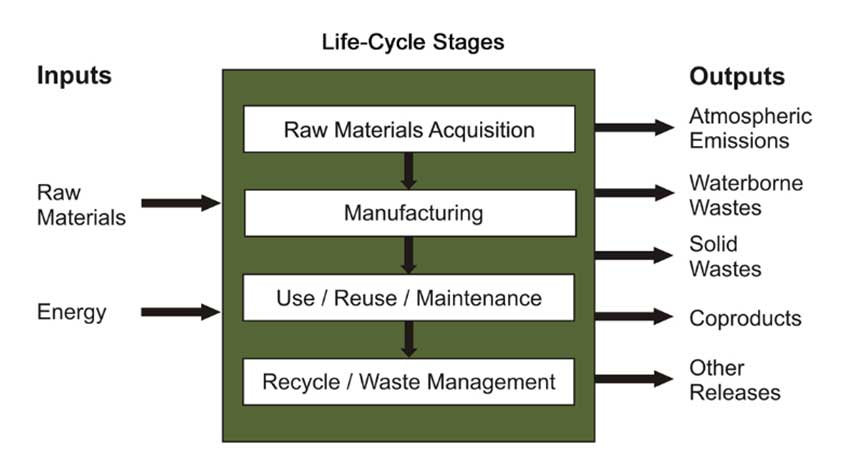
Figure 2: Life-cycle stages, inputs, and outputs for life-cycle assessment (adapted from USEPA).
Most importantly, because of concrete’s thermal mass, concrete buildings can be extremely energy-efficient. From a life-cycle perspective, concrete buildings perform well when compared to steel- and wood-frame buildings. As a result, concrete buildings have lower carbon footprint over their entire life cycle. This paper explores how life-cycle assessment (LCA) methods can be used to quantify and improve the environmental performance of a building.
What is Life-Cycle Assessment?
LCA is the investigation and evaluation of the environmental impacts of a product, process, or service. It is one of the best mechanisms for allowing architects and other building professionals to understand the energy use and other environmental impacts associated with all the phases of a building’s life cycle: procurement, construction, operation, and decommissioning. LCA evaluates all stages of a product’s life and considers each stage interdependently. There are several inputs, life-cycle stages, and outputs as shown in Figure 2.
Inputs include raw materials and energy. The output of an LCA can be thought of as a wide-ranging environmental footprint of a building. They include emissions, waterborne wastes, solid wastes, co-products, and other releases. These outputs are then converted to potential environmental impacts based on scientific knowledge of how these outputs affect the planet, ecosystems, and human health.
One environmental impact tool developed by the United States Environmental Protection Agency (EPA) is called the Tool for the Reduction and Assessment of Chemical and Other Environmental Impacts (TRACI). TRACI allows the examination of impacts associated with the raw material usage and energy consumption (inputs) and chemical releases (outputs) resulting from the processes involved in producing a product or, in this case, construction and operation of a building over a specific lifetime.
These environmental impacts include ozone depletion, global warming, acidification, eutrophication, photochemical smog, human health issues, ecotoxicity, fossil fuel use, land use, and water use, among others.
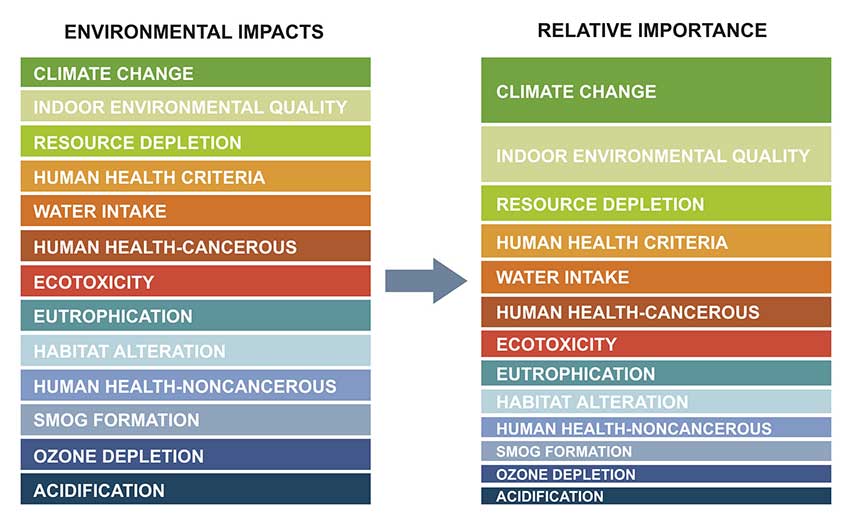
Image courtesy of NRMCA
Figure 4: Environmental impacts and relative importance of impacts (adapted from USGBC).
Figure 3 provides a schematic representation of potential environmental impacts, and one possible interpretation of their relative importance, for the purpose of identifying the most critical impacts. The relative importance of each impact might change depending on the product or process being analyzed or on other factors such as location and/or political influences. For example, many governments have declared climate change as today’s most important environmental impact. However, there are some locations where water is scarce and therefore water intake and waterborne releases may be a more immediate priority.
Assessing every stage of the environmental life cycle is essential to providing a comprehensive whole-building picture, and it allows designers and engineers to make decisions early in the process, resulting in lower total environmental impacts.
With so many inputs and outputs and associated environmental impacts for each life cycle, the whole-building picture is complex. For a building, energy and materials are consumed to manufacture building products, resulting in environmental releases and associated impacts. Impacts of transporting raw materials to the manufacturing facility and from the manufacturing facility to the construction site must also be accounted for. Similarly, there are inputs and environmental releases from the construction stage. The use or operational life-cycle stage impacts are significantly greater than those in the other life-cycle stages. A building usually operates for decades, consuming energy and raw materials with associated environmental releases. These operational stage impacts typically dwarf the environmental impacts from material extraction, manufacturing, and end-of-life stages for commercial and residential buildings.
The major hurdle to adopting LCA as a tool for evaluating and improving the environmental impacts of buildings has been the lack of data. Product manufacturers have been able to communicate their environmental impacts using a document called an Environmental Product Declaration (EPD), which provides information about environmental impacts such as global warming potential, smog formation, and water use, based on a comprehensive LCA of their product.
Manufacturers have often used a Product Category Rule (PCR), which is a standard that provides instructions on how to conduct the LCA to produce EPDs that are consistent within a product category (such as concrete, carpeting, ceiling tile, etc.). Generally, plant or site-specific data are more desirable for conducting an LCA for the product, but industry average data is sometimes used if site-specific data are not available. There are many concrete producers that have published product-specific EPDs and the National Ready Mixed Concrete Association (NRMCA) has published an industry-wide EPD that provides average impacts that can be used in lieu of product-specific EPDs.
Ideally, LCAs for products are conducted for the entire life cycle or from “cradle-to-grave.” However, for many products, their impacts during the use stage are minimal or life-cycle inventory data for the use stage is difficult or nearly impossible to obtain. In some cases, it may be preferable to conduct partial LCAs, such as “cradle-to-gate” type analyses where only the first two life-cycle stages (raw material acquisition and manufacturing) are included since these data are needed to conduct the more comprehensive whole-building LCA.
Operational stage impacts for a building are typically obtained by conducting a comprehensive energy analysis to identify the environmental impacts associated with heating, cooling, illuminating, and operating a building. The results of the energy analysis would be entered into LCA software as energy inputs, delineating what fuel type will be used and so on. In addition, information about water use, waste production, and any other source of emissions must be estimated to conduct a whole-building LCA.
For the past two decades, LCA databases have been collecting more data about materials, processes, energy, and transport that can be shared across the industry and around the world. “Best fit” data, appropriate use, and interpretation of results are complicated and still require discussion. As the demand for LCA data increases, and the conversation around it continues, data quality and assessment will likely improve.
How Can Concrete Help Reduce Life-Cycle Impacts of a Building?
Assessing all of the building materials in a project is a complex task. The best approach to reducing carbon impacts is starting with the products that have the biggest immediate impact: concrete, steel, and aluminum. When it comes to concrete, portland cement is responsible for most of the carbon emissions—roughly 90%. Reducing manufacturing process energy and identifying the places where high-emissions ingredients can be reduced and substituted, is one of the best approaches for addressing life-cycle impacts of a building.
Reduced Manufacturing Process Energy
Water, sand, stone, gravel, and other ingredients make up about 90% of a concrete mixture by weight. The process of mining sand and gravel, crushing stone, combining the materials in a concrete plant, and transporting concrete to the construction site, requires very little energy and therefore only emits a relatively small amount of CO2 into the atmosphere. The amount of CO2 embodied in concrete is primarily a function of the cement content in the mix.
Therefore, one of the most effective ways to reduce the embodied impacts of concrete manufacturing is to increase the use of industrial byproducts, such as fly ash, blast furnace slag, and silica fume, to supplement a portion of the cement used in concrete. These industrial byproducts, which would otherwise end up in landfills, are called supplementary cementitious materials or SCMs for short. SCMs work in combination with portland cement to improve strength and durability of concrete. In addition, their use reduces the CO2 embodied in concrete by as much as 70%, with typical reductions ranging from 15−40%, depending on the percentage replacement of portland cement.
Concrete producers also incorporate a variety of environmental best management practices in the production of concrete. These include the reuse and recycling of waste from concrete manufacture, such as water and unused returned concrete. It also incorporates waste byproducts from other industries such as recycled industrial wastewater, foundry sands, glass, and other materials that would typically end up in landfills. In addition to the use of SCMs in the concrete mix, concrete from demolition can be crushed and recycled as aggregate. Recycled aggregate is often used as backfill and pavement base and is sometimes used for making new concrete. Reinforcing steel in concrete, which is made from recycled materials, can be recycled and reused.
Portland-Limestone Cement
When narrowing down the carbon emissions in cement, the issue really comes down to clinker. The solid intermediate material produced in the manufacturing portland cement is created by sintering limestone and aluminosilicate materials, such as clay, during the kiln stage. That product is where most of portland cement’s emissions occur: About .90 to .92 tons of C02 can be associated with 1.0 ton of clinker. Increasing kiln efficiency by using dry instead of wet kilns is one way to reduce C02. The other way to reduce the clinker impacts lies in the processing and chemical formulation of the cement and in assessing the proportion of ingredients used.
As the cement industry pursues carbon reduction, acceptable alternatives to ordinary portland cement have surfaced. One of the most promising and immediate options is changing OPC, classified as Type I cement, to portland-limestone cement (PLC) classified as Type IL cement. PLC contains more ground limestone and can replace the amount of clinker required to be used in the cement. Ordinary portland cement is limited by definition and standards to a maximum of 5% limestone. Portland-limestone cement, on the other hand, is allowed to contain 5−15% limestone.
Limestone is softer than clinker and grinds preferentially. To effectively achieve equivalent performance, PLC is typically ground to a higher fineness than portland cement. While there is some evidence that limestone reacts chemically, the contribution to strength from chemical reactions is marginal. It is postulated that finer limestone particles improve particle packing in concrete (similar to fine SCMs) and provide reaction sites for more efficient hydration of cement. There is considerable research that compares and documents the equivalent performance of concrete made with PLC to those made with portland cements. These include the effects on fresh concrete, hardened concrete properties like strength and shrinkage, and, for impacts on durability such as freeze-thaw resistance, alkali-aggregate reactions and other properties.
An LCA report conducted by Athena Sustainable Materials Institute3 compared the GWP of a typical 5000 psi (35 MPa) concrete made with ordinary portland cement (OPC) and a PLC composition. Both concretes had identical mixture proportions, including the cementitious component. According to the Athena report, the GWP or carbon footprint of the concrete made with OPC is 299 kg CO2/m3 compared to 272 kg CO2/m3 for concrete made with PLC, which is a 9% reduction. PLC with 15% limestone would reduce carbon footprint further.
The use of both OPC and PLC has been researched, developed, and documented by industry-wide trade associations for both buildings and highways. The result of that work has been the development of standard specifications and testing requirements for different types of concrete, including the acceptance of Type IL cement in state specifications. ASTM C595 and the use of Type IL is accepted in the ACI 318, Building Code for Structural Concrete, ACI 301, Specification for Structural Concrete, ASTM C94, Specification for Ready Mixed Concrete and the AIA MasterSpec that is used by design firms to develop their specifications for private projects.
Approximately 100 million tons of cement are produced annually in the U.S., but only about 2 to 3% is currently specified and sold as PLC. Architects and other design professionals can help by changing their concrete specifications and including to Type IL PLC (ASTM C 595). Switching helps to move the entire construction industry toward environmentally responsible action. Industry wide, it is estimated that the switch to PLC could reduce energy consumption by 11.8 trillion Btus, and carbon dioxide emissions by more than 2.5 million tons, per year.
Durability, Thermal Properties, and Enhanced Concretes
Concrete structures can help reduce life-cycle impacts of buildings even after the manufacturing process and beyond construction. For instance, concrete structures withstand the test of time and, as a result, have low environmental impacts associated with maintenance and repair. In addition, concrete’s thermal- mass qualities reduce energy use throughout the life of the building.
Durability
For a building to last for generations, durability must be an inherent quality of its construction materials. Concrete does not rust, rot, or burn. Concrete buildings are durable, long-lasting structures that resist natural disasters such as hurricanes, tornadoes, earthquakes, fires, and floods. Because of its longevity, concrete is a viable solution for environmentally responsible design over the lifetime of a building. As a result, concrete buildings have low environmental impacts associated with maintenance and repair.
Thermal Mass
In a building, it is the mass of the building elements that stores heat during the hottest periods of the day and releases the heat during the cooler evening hours. Concrete is one of few building materials that possess thermal-mass properties. In the winter season, high-thermal-mass concrete walls and floors absorb radiant heat from the sun and gradually release it back into the occupied space during the night when the outdoor temperature drops.
High-thermal-mass buildings have distinct benefits. Reduction takes place through moderate shifts in peak loads of energy requirements due to the reduction in high fluctuations between indoor and outdoor temperatures. Heat transfer through a high-thermal-mass wall is reduced, and therefore less energy is used to heat and cool the interior space. The thermal mass of concrete delays peak temperatures, and reduces and spaces out peak energy loads, therefore shifting the energy demand to off-peak periods when utility rates may be lower.
Enhanced Concrete
Enhanced concrete is specially designed concrete for particular uses, from large civil engineering projects like bridges and dams to thin concrete structures in residential projects. Some examples are year-round, high-early-strength, self-consolidating, and high-performance, among others. These concrete technologies create more strength, rigidity and durability characteristics, which allows them greater longevity and can cut back on other emission sources related to construction timelines. Enhanced concretes can be specified for low-carbon options, with optimized mixes that use positive properties of SCMs.
RESEARCH ON LCA FOR CONCRETE
Though more assessments have been done in recent years, there are still relatively few examples of whole-building LCAs in the literature. LCA is still a relatively new science for the purposes of measuring environmental impacts of buildings and can be extremely time consuming and expensive. Most researchers have only conducted partial LCAs and choose to limit the scope of an LCA by ignoring certain life-cycle stages because of the lack of data or scope of research. Others focus on specific impacts to simplify the LCA process. The following are several examples of research that compare the life-cycle impacts of concrete, steel, and wood-framed buildings.
A comprehensive whole-building LCA study was conducted at MIT and published in a report titled Methods, Impacts, and Opportunities in the Concrete Building Life Cycle. The research explores and advances key areas relevant to the field of whole building LCA, including methodology, benchmarking, and impact reduction. In particular, the research compared the environmental impacts of a concrete building to a steel building for a large commercial structure in two different climate zones and of single and multifamily structures built with concrete and wood-frame in two different climate zones.
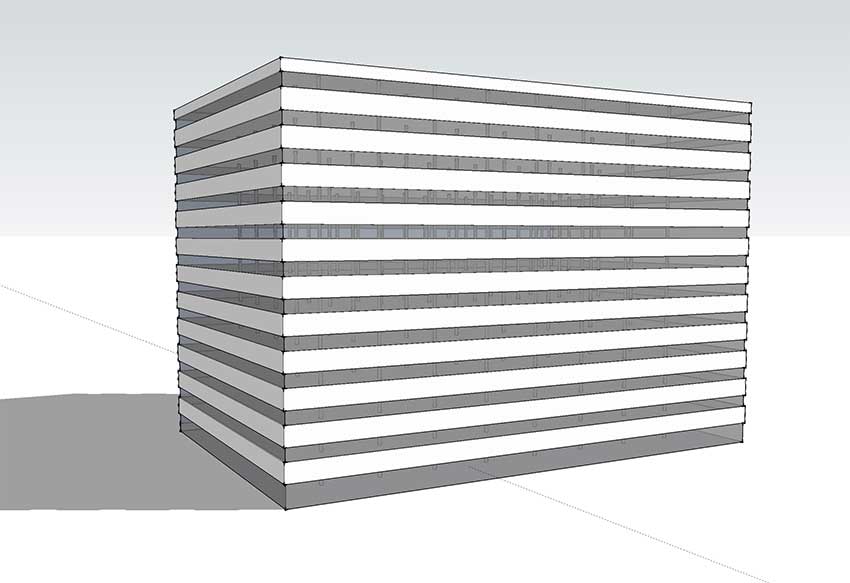
Image courtesy of NRMCA
Figure 5: Twelve-story commercial building with 40% glazing and 60% aluminum panels studied at MIT.
LCA of a Commercial Building
The comprehensive LCA was conducted for a 12-story, 46,321-square-meter (498,590-square-foot) commercial building (Figure 5). The building was analyzed for two climates, Phoenix and Chicago, and for two different structural materials, concrete and steel. The annual operating energy, determined using building energy analysis software, was conducted for a 60-year life cycle. The Global Warming Potential (GWP) was quantified using CO2 equivalents (CO2e) for several purposes, including benchmarking emissions for current construction practices, comparing impacts of concrete versus steel, and understanding the relative magnitude of impacts for different life-cycle stages.
The analysis demonstrated that the greenhouse gas emissions due to operational energy of the benchmark buildings are responsible for 95-96% of life-cycle emissions. Compared to the steel structure, the concrete building has approximately the same embodied emissions (pre-use, maintenance, and end-of-life phases) but have lower operating emissions (use stage).
The LCA research drew several conclusions, including:
The concrete and steel commercial buildings studied had similar embodied GWP of 42 lbs CO2e/ft2 (205 kg CO2e/m2); Thermal mass of an exposed concrete frame can provide HVAC savings of 7-9% compared to a steel frame. This accounts for 2% savings in annual operating emissions; Over a lifetime of 60 years, the CO2e emissions of the concrete building were slightly lower than the steel alternative (see Figure 6).
Finally, several recommendations for reducing life-cycle emissions of concrete buildings were presented. In particular, the GWP reduction effects of SCMs in concrete, such as fly ash, were quantified. Additional options for reducing operating emissions were introduced and quantified within the full life cycle. There are a number of potential emissions reduction strategies for concrete buildings and LCA provides guidance for future environmental improvements, including:
- Increasing SCM substitution (such as fly ash) in the concrete building from 10% to 25% can decrease pre-use GWP for the building by 4.3%.
- Low-lift cooling can decrease the operating energy requirements for concrete buildings since low-lift cooling takes advantage of the high heat capacity of concrete.
LCA of a Single-Family and Multifamily Building
The same general methodology was applied to structures used in residential applications. LCA was conducted for a two-story, 2,400-square-foot (223-square-meter), single-family building and a four-story multifamily apartment building with a total square footage of 33,763 square feet (3,137 square meters), as shown in Figure 7. The concrete buildings were designed using Insulated Concrete Form (ICF) construction consisting of concrete walls encased in expanded polystyrene (EPS) insulation. The wood buildings were designed using typical light-frame wood construction. For all buildings, the roof, partitions, and floors are designed in the same manner. Design of the exterior walls and foundations vary between the different buildings.
The LCAs were carried out for two different cities in the U.S. to model regional and climatic differences―Chicago, representing a cold climate, and Phoenix, representing a hot, dry climate. The annual operating energy, determined using energy analysis software, was conducted for a 60-year life cycle.
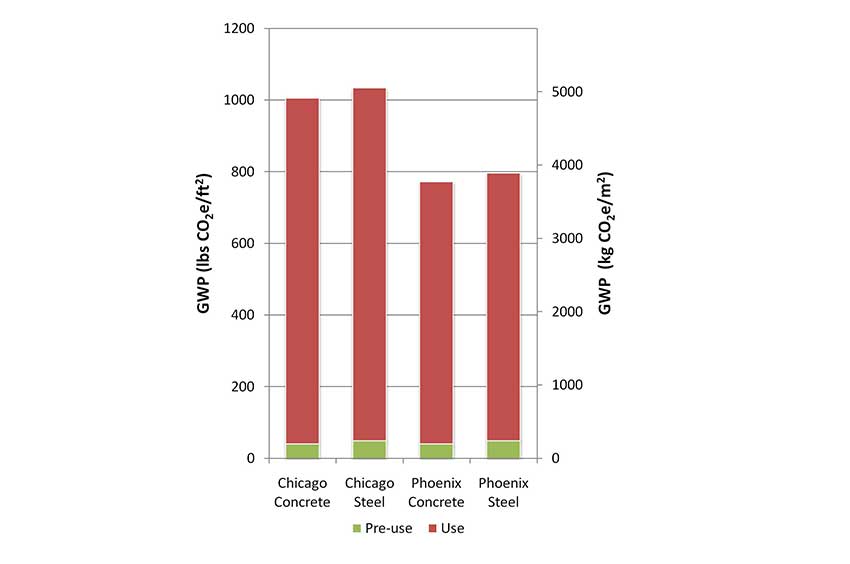
Image courtesy of NRMCA
Figure 6: Total global warming potential (GWP) over 60-year life span for a commercial building.
The resulting Global Warming Potential (GWP) was then quantified using CO2-equivalents (CO2e) for a number of purposes, including benchmarking emissions for current practices, comparing concrete with wood, and understanding the relative importance of different life-cycle stages. In particular, the research demonstrates that there are measureable differences between various construction materials and that concrete structures can provide unique benefits compared to other materials over an operating life cycle.
According to the report, concrete homes have a higher embodied GWP in the pre-use stage, but this stage accounts for only about 2-12% of the overall GWP for the life of the home. For a cold climate, such as Chicago, the energy savings of an ICF house built from average to-tight levels of air infiltration saves 23% of total operating energy; and over a 60-year life cycle, the lower operating GWP of the concrete buildings outweigh pre-use emissions resulting in 5-8% lower GWP for single-family and 4.4-6.2% lower GWP for multifamily (see Figure 8).
The MIT study offered a number of opportunities for reducing GWP of concrete residential buildings:
Moving from a 6-inch (15.2 cm) to a 4-inch (10.2 cm) concrete core is both cost-effective and reduces emissions; using ICFs with thicker insulation panels, increasing air tightness, and using thinner concrete walls can reduce GWP; and increasing SCM substitution from 10% to 50% in the ICF walls reduces the pre-use GWP by 12% to 14%.
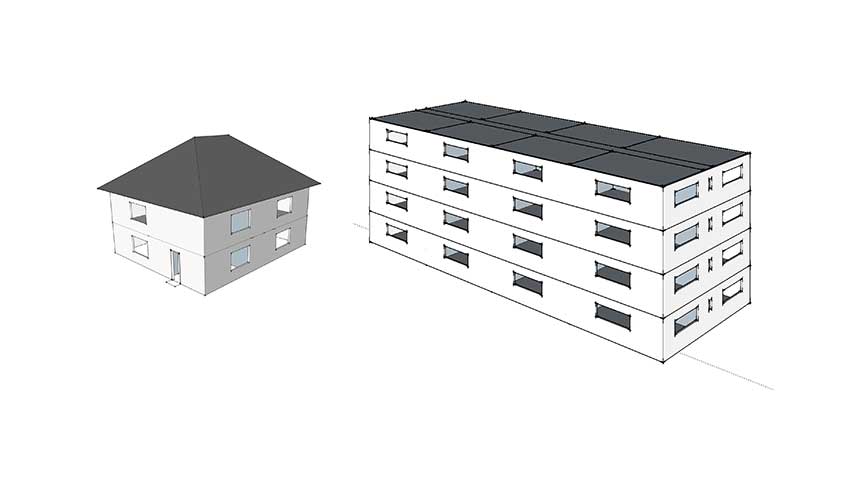
Image courtesy of NRMCA
Figure 7: Two-story, single-family and four-story, multifamily buildings studied by MIT.
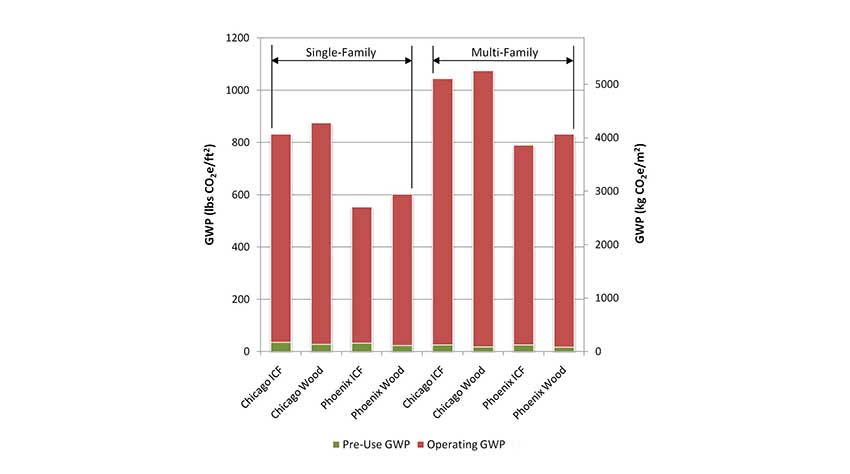
Image courtesy of NRMCA
Figure 8: Pre-use and operating GWP over 60-year life span for single-family and multifamily residential buildings.
Whole-Building LCA in the Green Building Standards
Although whole-building LCA is complex, it has been incorporated into green building codes, standards, and rating systems. To conduct a complete whole-building LCA, one needs life-cycle data for all the significant building materials and products, along with the operational data for the building including energy use, water use, waste production, and so on. However, most of the green building standards specify limited LCAs to measure only the embodied environmental impacts of building products. They rely on other requirements for energy conservation, water use reduction, and other strategies to reduce the environmental impacts of building operations.
These green building codes, standards, and rating systems typically require an LCA comparison between two building designs,―a reference or baseline building, and the proposed building. To comply, the proposed building must achieve a specified minimum reduction in several impact categories compared to the reference building. Green building standards within the U.S. that have adopted LCA include LEED v4, Green Globes, International Green Construction Code (IgCC), ASHRAE 189.1, and Living Building Challenge.
LEED v4 has a credit called Building Life-Cycle Impact Reduction that awards the project 3 points for conducting a whole-building LCA of the project’s structure and enclosure and can demonstrate a minimum of 10% reduction, compared with a reference building, in at least three of the following six impact categories:
- Global Warming Potential (Required)
- Reduce Ozone Depletion
- Land /Water Acidification
- Eutrophication
- Tropospheric Ozone
- Nonrenewable Energy
Recent Large-Scale LCA Research on U.S. Buildings and Pavements
In a recent study, a team of former and current MIT researchers at the Concrete Sustainability Hub (CSHub) found that emissions of U.S. buildings and pavements could be reduced by around 50% even as the worldwide use of concrete increases. That study, “The role of concrete in life-cycle greenhouse gas emissions of US buildings and pavements,” was published September 2021 in the Proceedings of the National Academy of Sciences (PNAS) and shows how it can be achieved.
This extensive analysis of building and pavement sectors illustrates how life-cycle assessment can be done on a grand scale to reduce emissions in concrete. The team analyzed a “projected” and “ambitious” scenario of reduction strategies and system attributes for buildings and pavements over the 34-year analysis period. The study showed that even if concrete was accelerated, emissions for pavements and buildings between 2016 and 2050 could fall by up to 65% and 57%, respectively, enabling the U.S. to attain carbon neutrality by 2050, close to Paris Climate Accords reduction targets. That prediction assumed continuing carbon reduction and energy-efficiency strategies (and strategies were limited to technologies that currently exist) but they have not been adopted on a large scale.
To conduct this study, the team used reference designed intended to represent current and future building and pavement. They collected current stock within the pavement and building sector in detail, factoring in a variety of elements. For future action, they used several scenarios reflecting current trends. Projected scenarios for buildings and pavements featured the gradual introduction of low-carbon concrete strategies including use of recycled content, carbon capture in cement production, and the use of captured carbon to produce aggregates and cure concrete. In a more ambitious scenario, they used the same strategies implemented more aggressively.
Results showed that the majority of GHG emissions from new buildings and pavement would be from operational consumption rather than embodied emissions, and that it would be essential to place these initial impacts in the context of the material’s life cycle.
What the team found was that more than 80% of the total emissions from new buildings and pavements between 2016 and 2050 would derive from their operation, suggesting that ambitious interventions to the electricity grid and other operational emissions can have the greatest impact.
Overall, the MIT team found that as the U.S. continues to use more concrete, the benefits of the material itself (and the modifications made to it) can make climate targets more achievable.
LCATools At Work
Mix designs selected for the reference building (from NRMCA benchmark report): A cradle-to-gate LCA was conducted to determine the embodied impacts of concrete on a building to compare the GWP of a reference building using typical concrete mixes with moderate amounts of SCMs (both fly ash and slag) and a proposed building using concrete mixes with relatively high volumes of fly ash and slag. The building is an 18-story residential tower located in the northeast United States. For illustration purposes, only six different concrete mixes are selected for the project. In reality, a project of this size might have more concrete mixes. Compressive strengths and concrete volumes for each structural element are identified in Figure 9.
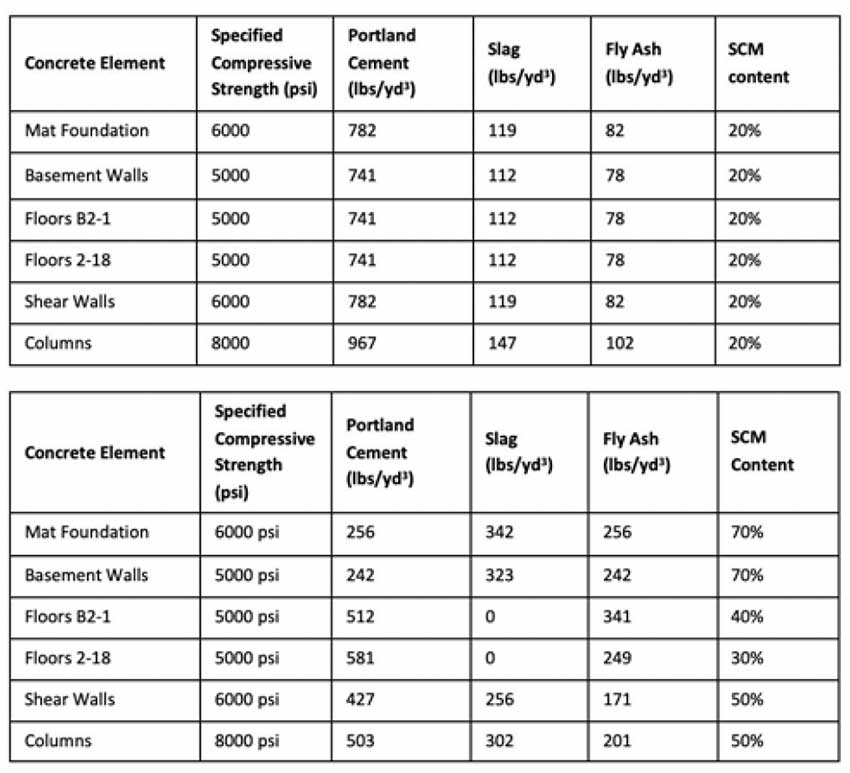
A summary of the concretes selected for the reference and proposed building are provided in Tables 1 and 2.
The first step in the analysis is to identify typical concrete mixes for the reference building. In 2014 (updated in 2016), NRMCA published benchmark mix designs and their environmental impacts for eight different regions in the United States. This example uses the benchmark mix designs for the Northeast region. The next step is to estimate mix designs that have significantly lower GWP than the benchmark mixes that still meet the performance criteria (strength, durability, etc.). Keep in mind that concrete requiring high-early-strength should be limited to around 30% replacement of fly ash or slag. Concrete that does not require early age strength such as footings, basement walls, and even some vertical elements such as columns and shear walls, could have as much as 70% fly ash and/or slag, and could be tested at 56 or 90 days instead of 28 days to account for slower strength gain. This example uses high-volume SCM mixes from the NRMCA Industry-Wide EPD. Using the Athena Impact Estimator for Buildings (Athena IE) software, the reference building and proposed building were defined using the proposed mixes in Tables 1 and 2, respectively. Athena IE has the NRMCA benchmark mixes and the NRMCA industry-wide EPD mixes pre-loaded into the software. The software also permits the user to define new mixes based on the existing mixes in the library or completely new mixes if that information is available from a concrete producer. Once all the concrete information is defined for each project, the user can then run a report that will provide the estimated GWP, along with other impacts, for each building. The reference building will represent the largest impacts and the proposed designs will represent lower impacts. The results for this example showed that the reference building has a GWP for concrete of 6.14 million kg CO2 while the proposed building has a GWP for concrete of 3.92 million kg CO2, meaning that the high volumes of fly ash and slag mixes resulted in 36% reduction in GWP. Keep in mind, this is example was simplified for illustration purposes. It only considered the effects of concrete during the material extraction and manufacturing stage on the environmental impacts of the building. For LEED v4, one must consider the impacts of all the materials and products associated with the structure and enclosure, including structural elements such as concrete, reinforcing steel and structural steel (including fireproofing), and exterior cladding such as glass, aluminum, and insulation. The Athena IE software does contain environmental impact information for most materials and products used in buildings, and it outputs the six environmental impacts required for the LEED v4 LCA credit. In addition, the Athena LCA software allows the user to input energy consumption data obtained from an energy analysis, making it an ideal tool for conducting whole-building LCA.
CONCLUSION AND REVIEW
Environmental life-cycle assessment (LCA) is a valuable tool for assessing the environmental impact of buildings. It is extremely important to include the operational stage of a building life cycle, since the operational stage impacts dwarf the impacts of material extraction, manufacturing, construction, and end-of-life life-cycle stages combined. LCA provides a scientific approach to evaluating the merits of design alternatives. For the few LCAs conducted that compare the environmental impacts of steel, wood, and concrete buildings, it has been demonstrated that concrete buildings can offer energy savings and significant reductions in carbon emissions. Concrete building systems, such as insulating concrete forms, combine insulation with high thermal mass and low air infiltration to make buildings more energy efficient, therefore reducing the environmental impacts of buildings over their entire life cycle.
REFERENCES
NRMCA Member Industry-Wide EPD for Ready Mixed Concrete, National Ready Mixed Concrete Association, Silver Spring, MD, 2016. www.nrmca.org/sustainability.
Energy Information Administration, 2016.
Ochsendorf, J., et al., Methods, Impacts, and Opportunities in the Concrete Building Life Cycle, Massachusetts Institute of Technology Concrete Sustainability Hub, Cambridge, MA, 2011.
NRMCA Member National and Regional Life Cycle Assessment Benchmarks (Industry Average) Report, National Ready Mixed Concrete Association, Silver Spring, MD, 2016. www.nrmca.org/sustainability.
Erika Fredrickson is an independent writer and editor focusing on technology, the environment, and history. She is a frequent contributor for continuing education courses and publications through Confluence Communications. www.confluencec.com


